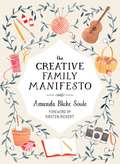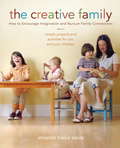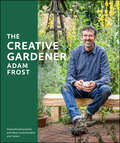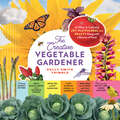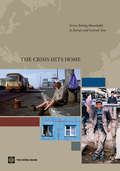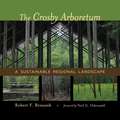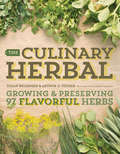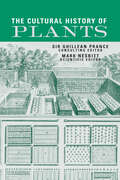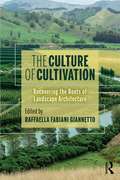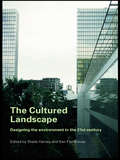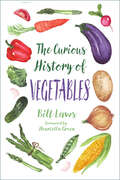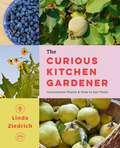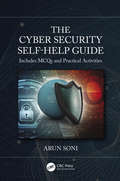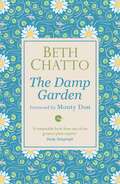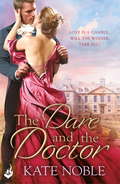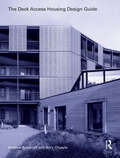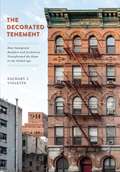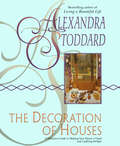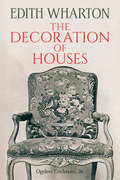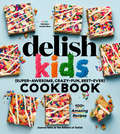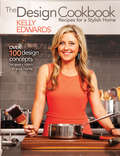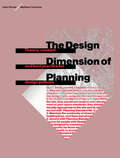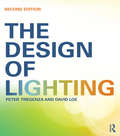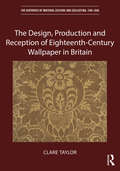- Table View
- List View
The Creative Family Manifesto: Encouraging Imagination and Nurturing Family Connections
by Amanda Blake SouleSpark and nurture your family's creativity--a guide for making creativity an intentional part of everyday life.When you learn to awaken your family's creativity, wonderful things will happen: you'll make meaningful connections with your children in large and small ways; your children will more often engage in their own creative discoveries; and your family will embrace new ways to relax, play, and grow together. With just the simple tools around you--your imagination, basic art supplies, household objects, and natural materials--you can transform your family life, and have so much more fun! This book embraces a whole new way of living that will engage your children's imagination, celebrate their achievements, and help you to express love and gratitude for each other as a family.
The Creative Family: How to Encourage Imagination and Nurture Family Connections
by Amanda Blake SouleWhen you learn to awaken your family's creativity, wonderful things will happen: you'll make meaningful connections with your children in large and small ways; your children will more often engage in their own creative discoveries; and your family will embrace new ways to relax, play, and grow together. With just the simple tools around you--your imagination, basic art supplies, household objects, and natural materials--you can transform your family life, and have so much more fun! Amanda Soule has charmed many with her tales of creativity and parenting on her blog, SouleMama. Here she shares ideas and projects with the same warm tone and down-to-earth voice. Perfect for all families, the wide range of projects presented here offers ideas for imaginative play, art and crafts, nature explorations, and family celebrations. This book embraces a whole new way of living that will engage your children's imagination, celebrate their achievements, and help you to express love and gratitude for each other as a family. To learn more about the author, Amanda Soule, visit her blog at www.SouleMama.com.
The Creative Gardener: Inspiration and Advice to Create the Space You Want
by Adam FrostClever ideas and imaginative solutions from BBC Gardeners&’ World host Adam Frost to help you transform your garden, element by element, into a personalized dream space. Adam shows how small plantings, design flourishes, hands-on creative projects, and simple hard landscaping projects can help transform your garden. Taking an artisan&’s approach to his own garden, Adam emphasizes how you too can find inspiration and turn it into a garden feature, how to personalize your ideas – using what you already have – and upcycling. There&’s something to suit everyone&’s taste, space, and budget. Each project starts with Adam's inspiration, and then walks the reader through how he created the end product with clear step-by-step photography and instructions. Adam shows that inspiration doesn't have to come from other gardens. In fact, for him, it rarely does. It could be a natural feature such as a heap of wood, something you already own, or a salvage yard item you can upcycle. With a little work and a dash of imagination, you can create something truly personal in the garden and create the atmosphere you want, while developing your skills and enjoying the creative process. Well known for his straightforward, clear presentation, and his award-winning design ideas, Adam combines these skills to offer realistic, achievable, impactful suggestions for transforming your space. Element by element, a weekend at a time, he can help you create the garden you&’ve always wanted.
The Creative Vegetable Gardener: 60 Ways to Cultivate Joy, Playfulness, and Beauty along with a Bounty of Food
by Kelly Smith TrimbleWith interest in vegetable gardening booming, lifestyle editor and master gardener Kelly Smith Trimble offers designs, ideas, and inspiration for making the vegetable garden a joyful, creative space that reflects each gardener's distinctive aesthetic, integrates beauty with functionality, and offers a sanctuary for both people and pollinators, along with a bounty of nutritious, homegrown food.
The Crisis Hits Home: Stress Testing Households in Eastern Europe and Central Asia
by Victor Sulla Victoria Levin Erwin R. Tiongson Kalanidhi Subbarao Ashley Taylor Naotaka Sugawara Anna I. GueorguievaThe crisis threatens the welfare of about 160 million people in the Europe and Central Asia (ECA) region who are poor or are just above the poverty line. Using pre-crisis household data along with aggregate macroeconomic out-turns to simulate the impact of the crisis on households--transmitted via credit market shocks, price shocks, and income shocks--this report finds that adverse effects are widespread and that poor and non-poor households alike are vulnerable. By 2010, for the region as a whole, some 11 million more people will likely be in poverty and over 23 million more people will find themselves just above the poverty line because of the crisis. The aggregate results mask the heterogeneity of impact within countries, including the concentration of the poverty impact in selected economic sectors. Meanwhile, stress tests on household indebtedness in selected countries suggest that ongoing macroeconomic shocks will expand the pool of households unable to service their debt, many of them from among the ranks of relatively richer households. In fact, already there are rising household loan delinquency rates. Finally, there is evidence that the food and fuel crisis is not over and a new round of price increases, via currency adjustments, will have substantial effects on net consumers. Lessons from last year's food crisis suggest that the poor are the worst hit, as many of the poor in Albania, Kyrgyz Republic, and Tajikistan, for example, are net food consumers, with limited access to agricultural assets and inputs. The resilience of households to macroeconomic shocks ultimately depends upon the economy's institutional readiness, the flexibility of the economic policy regime, and the ability of the population to adjust. However, compared with previous crises, the scope for households to engage in their traditional coping strategies may be more limited. Fiscal policy responses in the short-term are also constrained by rapidly falling revenues. Governments in ECA have to make difficult choices over what spending items to protect and what items to cut, social protection programs to reform and scale-up, and new interventions to mitigate the impact of the crisis.
The Crosby Arboretum: A Sustainable Regional Landscape (Reading the American Landscape)
by Robert F. Brzuszek Neil G. OdenwaldSince its genesis in 1980, Crosby Arboretum in southern Mississippi has attracted international recognition for its contributions to architecture, biology, and landscape design. Now owned and operated by Mississippi State University, Crosby is the first fully realized ecologically designed arboretum in the United States and the premier native plant conservatory in the Southeast.Former site director and curator Robert F. Brzuszek provides a detailed survey of the arboretum's origins, planning, construction, and ongoing management. More than just a botanical center, Crosby emerged as one of the first American landscape projects to successfully balance natural habitat and planned design. The book's generous selection of photographs and drawings illustrate the beauty and purpose of the site's components: the award-winning Pinecote Pavilion, designed by architect Fay Jones; a 104-acre focus area that includes the Piney Woods Lake, which displays native water plants in their natural setting; and seven hundred additional acres of savanna, woodland, and aquatic environments that nurture more than 300 species of indigenous trees, shrubs, wildflowers, and grasses. Utilizing the interactions between two opposing natural forces -- fire and water -- Crosby Arboretum protects the biological diversity indigenous to the Pearl River Drainage Basin, in southern Mississippi and southeastern Louisiana. Brzuszek's inspiring and informative account will help further Crosby's role as a model of sustainable landscape design and management across the country.
The Culinary Herbal: Growing and Preserving 97 Flavorful Herbs
by Arthur O. Tucker Susan Belsinger Shawn Linehan“This fresh new masterpiece excites the senses!” —Rosemary Gladstar, herbalist and bestselling author Good cooks know that when it comes to herbs, there is nothing better than those that are clipped fresh from the garden. The Culinary Herbal highlights 97 delicious varieties—like black cumin, fenugreek, lemon balm, and sassafras—that every food lover will want to add to their kitchen garden. In this gorgeously photographed guide, home cooks will learn which herbs offer the most flavor, how to grow them at home, and how to put them to use. Plant profiles are organized alphabetically by herb type and include basic growing information, flavor notes, and culinary uses. Additional information includes step-by-step instructions for harvesting, preserving, and storing, along with techniques for making pastes, syrups, vinegars, and butters.
The Cultural History of Plants
by Mark Nesbitt Ghillean PranceThis valuable reference will be useful for both scholars and general readers. It is both botanical and cultural, describing the role of plant in social life, regional customs, the arts, natural and covers all aspects of plant cultivation and migration and covers all aspects of plant cultivation and migration. The text includes an explanation of plant names and a list of general references on the history of useful plants.
The Culture of Cultivation: Recovering the Roots of Landscape Architecture
by Raffaella Fabiani GiannettoBy seeking to rediscover the profession's agricultural roots, this volume proposes a 21st-century shift in thinking about landscape architecture that is no longer driven by binary oppositions, such as urban and rural; past and present; aesthetics and ecology; beautiful and productive, but rather prioritizes a holistic and cross-disciplinary framing. The illustrated collection of essays written by academics, researchers and experts in the field seeks to balance and redirect a current approach to landscape architecture that prioritizes a narrow definition of the regional in an effort to tackle questions of continuous urban growth and its impact on the environment. It argues that an emphasis on conurbation, which occurs at the expense of the rural, often ignores the reality that certain cultivation and management practices taking place on land set aside for production can be as harmful to the environment as is unchecked urbanization, contributing to loss of biodiverstiy, soil erosion and climate change. By contrast, the book argues that by expanding the expertise of design professionals to include the productive, food systems, soil conservation and the preservation of cultural landscapes, landscape architects would be better equipped to participate in the stewardship of our planet. Written primarily for landscape practitioners and academics, cultural and environmental historians and conservationists, The Culture of Cultivation will appeal to anyone interested in a thorough rethinking of the role and agency of landscape architecture.
The Cultured Landscape: Designing the Environment in the 21st Century
by Ken Fieldhouse Sheila HarveyThis book poses important philosophical questions about the aims, values and purposes of landscape architecture. The editors, highly regarded in their field, have drawn together a distinguished team of writers who provide unique individual perspectives on contemporary themes from a wide base of knowledge. Altogether, this key international study raises awareness of the landscape and encourages innovative ways of thinking about quality in design.
The Curious History of Vegetables: The Curious History of Vegetables
by Bill Laws Henrietta GreenCouch potatoes are idlers, cabbageheads are dunces, swede-bashers are stupid and you may as well give up life if you become a vegetable.A vegetable existence may imply dull monotony, but the humble vegetable has sparked protests, threatened to topple a British government and almost triggered a revolution. From the Scottish Presbyterian campaign against the ‘sinful potato’ to the class act that turned the carrot into a propaganda tool, from garlic inscriptions on Egyptian pyramids to Neolithic broad beans and medieval cabbage, and from the Dig for Victory campaign to competitive vegetable growing, The Curious History of Vegetables highlights just how vital our produce really is.
The Curious Kitchen Gardener: Uncommon Plants and How to Eat Them
by Linda ZiedrichEnjoy a whole new tasty cuisine using unexpected ingredients you can find in your own garden, from a Master Food Preserver and Gardener.The Curious Kitchen Gardener is for cooks and gardeners interested in bringing novelty and variety into their lives and homes. It follows each season of planting and harvesting—featuring nearly 35 often overlooked edibles, with illustrations, and a delicious recipe for each, encouraging us to see our gardens as an integrated whole and a year-round practice. Calling upon decades of Master Gardener and Master Food Preserver experience, Linda Ziedrich includes fascinating cultural context and personal connections to each plant. The result is the story of how and why an adventurous gardener cultivated a unique cuisine for herself and her family—and how you can too.
The Cybersecurity Self-Help Guide
by Arun SoniCybercrime is increasing at an exponential rate. Every day, new hacking techniques and tools are being developed by threat actors to bypass security systems and access private data. Most people do not know how to secure themselves, their devices, and their media shared online. Especially now, cybercriminals appear to be ahead of cybersecurity experts across cyberspace. During the coronavirus pandemic, we witnessed the peak of cybercrime, which is likely to be sustained even after the pandemic. This book is an up-to-date self-help guide for everyone who connects to the Internet and uses technology. It is designed to spread awareness about cybersecurity by explaining techniques and methods that should be implemented practically by readers. Arun Soni is an international award-winning author who has written 159 books on information technology. He is also a Certified Ethical Hacker (CEH v8) from the EC-Council US. His achievements have been covered by major newspapers and portals, such as Business Standard, The Economic Times, Indian Express, The Tribune, Times of India, Yahoo News, and Rediff.com. He is the recipient of multiple international records for this incomparable feat. His vast international exposure in cybersecurity and writing make this book special. This book will be a tremendous help to everybody and will be considered a bible on cybersecurity.
The Damp Garden
by Beth Chatto'A remarkable book from one of our greatest plant experts' DAILY TELEGRAPHWith a new introduction by Monty DonIn revealing what worked in her own garden, Beth Chatto passes on a wealth of advice gleaned from her personal experience. She provides detailed - and accessible - ideas on garden management, plans for every type of soil and situation, nearly twenty specially tailored lists to help with planting in various conditions, and descriptions of over a thousand suitable plants for making the most of damp ground.
The Dare and the Doctor: Winner Takes All 3 (Winner Takes All)
by Kate NobleFrom Kate Noble, part of the sensational writing team behind The Lizzie Bennet Diaries, comes the third novel in a dazzling and superbly witty historical romance series that's part Trading Places, part Pride and Prejudice. Perfect for fans of Julia Quinn, Stephanie Laurens and Tessa Dare.The best of friends might be the perfect match . . . What's the worst that can happen?Margaret Babcock had always been content with her quiet life in the country. But with her late mother's words 'What's the worst that could happen?' ringing in her ears, she longs to spread her wings. So when her long-time correspondent Dr Rhys Gray invites her to London, she eagerly accepts.Many happy hours are spent touring the wonders of the city - purely as friends, of course. But would friends miss each other so fiercely when they're apart? Or feel such a spark together? And matters are complicated even further when it transpires that Rhys may be promised to another. Will their 'friendship' survive?Be dazzled by Kate Noble's previous Winner Takes All books: The Game and the Governess and The Lie and the Lady.
The Deck Access Housing Design Guide: A Return to Streets in the Sky
by Andrew Beharrell Rory OlcaytoThe Deck Access Housing Design Guide is the first practical design guide to deck access housing. It focuses on the contemporary use of deck access housing, sharing practical guidance and providing in-depth case studies, while also presenting historical context about this flexible and evolving housing type. Despite a chequered history that saw it linked with urban decay and social malaise in the 1970s and 80s, deck access housing today, after a 40-year hiatus, is fast becoming the default solution for mid-rise housing in the UK, and London in particular. This is in part down to architects’ renewed interest in post-war Modernist typologies, but also due to specific planning standards that favour the qualities – dual-aspect plans, ‘public’ front doors – of deck access design. This comprehensive, professional guide spotlights the best contemporary deck access housing in the UK and throughout mainland Europe, explaining and analysing exemplars in detail. Illustrated in full colour throughout with plans, elevations, photographs, project data and annotations, case studies include both new build and retrofit projects, in public housing, co-housing and Third Age residential projects. Good architectural practice flows from an informed understanding of cultural and design history coupled with practical guidance and clear analysis of case studies. That is what this book provides for anyone interested in, or involved in the design and delivery of, deck access housing. Featured architects from the UK: AHMM · Apparata · Cartwright Pickard · Collective Architecture · DO Architecture · Hawkins Brown · Haworth Tompkins · Henley Halebrown · Levitt Bernstein · Maccreanor Lavington · Mæ · Matthew Lloyd · Pitman Tozer · Pollard Thomas Edwards · Proctor & Matthews · PRP · RCKa Featured architects from mainland Europe: ANMA · Arquitectura Produccions · Atelier Kempe Thill · Bureau Massa · DAMAST · Estudio Herreros · Fink + Jocher · KAAN · LEVS · Martin-Löf · MEF · Muñoz Miranda · Passelac & Roques · Waechter + Waechter
The Declutter Challenge: A Guided Journal for Getting your Home Organized in 30 Quick Steps
by Cassandra AarssenFifty ways to make your home a sustainable and eco-friendly environment. Every decision you make, large and small, has an impact on the environment. This concise guide shows how you can make your daily impact planet-positive. With sections progressing from simple tips to deeper commitments, you can start with baby steps and move on to advanced eco-warrior! Discover dozens of inspired ideas that show how to: Reduce your waste Eat organic Keep toxins out of your home Compost leftover food Shop wisely, and much more
The Decorated Tenement: How Immigrant Builders and Architects Transformed the Slum in the Gilded Age
by Zachary J. VioletteWinner of the International Society of Place, Landscape, and Culture Fred B. Kniffen AwardA reexamination of working-class architecture in late nineteenth-century urban AmericaAs the multifamily building type that often symbolized urban squalor, tenements are familiar but poorly understood, frequently recognized only in terms of the housing reform movement embraced by the American-born elite in the late nineteenth century. This book reexamines urban America&’s tenement buildings of this period, centering on the immigrant neighborhoods of New York and Boston. Zachary J. Violette focuses on what he calls the &“decorated tenement,&” a wave of new buildings constructed by immigrant builders and architects who remade the slum landscapes of the Lower East Side of Manhattan and the North and West Ends of Boston in the late nineteenth century. These buildings&’ highly ornamental facades became the target of predominantly upper-class and Anglo-Saxon housing reformers, who viewed the facades as garish wrappings that often hid what they assumed were exploitative and brutal living conditions. Drawing on research and fieldwork of more than three thousand extant tenement buildings, Violette uses ornament as an entry point to reconsider the role of tenement architects and builders (many of whom had deep roots in immigrant communities) in improving housing for the working poor.Utilizing specially commissioned contem-porary photography, and many never-before-published historical images, The Decorated Tenement complicates monolithic notions of architectural taste and housing standards while broadening our understanding of the diversity of cultural and economic positions of those responsible for shaping American architecture and urban landscapes. Winner of the International Society of Place, Landscape, and Culture Fred B. Kniffen Award
The Decoration of Houses
by Alexandra StoddardAlexandra Stoddard continues her creative and insightful guidance by showing us how to make our homes a real expression of our true selves. Starting with the Fifteen Defining Principles of Interior Design, Stoddard grounds us in the classic standards that make any home timeless and follows with inventive suggestions. Her own bold ideas about color, pattern, and texture are affordable tips from her own vast experience involving every imaginable decoration problem. From lighting a room to adding fabrics, furnishings, and the perfect finishing touches, she offers her expertise while always encouraging us to listen to our inner voice for the final answer.
The Decoration of Houses (Dover Architecture)
by Edith Wharton Ogden Codman Jr.Thousands of books on interior design have come and gone since the 1897 publication of this pioneering manual, but The Decoration of Houses remains, thanks to the insightful and inspiring advice of its co-authors. Before she became the Pulitzer Prize-winning author of The Age of Innocence, Edith Wharton was a society matron, remodeling a summer home in Newport, Rhode Island. With the able assistance of architect Ogden Codman, Jr., Wharton assembled this corrective to the rampant vulgarity of her nouveau riche neighbors. Wharton and Codman defied the excesses of the Gilded Age, counseling readers to reject the popular penchant for clutter in favor of simplicity and balance.More than an engaging item of period charm, this historic guide offers examples of design rooted in architectural principles. Black-and-white photographs illustrate the authors' ideals of classic beauty, depicting grand ballrooms and spacious boudoirs as well as the elements common to homes of every size and era: doors and windows, walls and ceilings, floors, halls, and stairs. One of the genre's most important and influential titles, this volume sparked a Renaissance in American interior design, and its sound advice and practical approach remain forever in style.
The Delish Kids (Super-Awesome, Crazy-Fun, Best-Ever) Cookbook: 100+ Amazing Recipes
by Joanna SaltzThe ultimate learn-how-to-cook book filled with 100+ amazing, easy-to-follow recipes for every occasion plus helpful kitchen tricks to inspire young cooks This best-ever kids&’ cookbook from Delish is filled with recipes that make cooking so much fun. Throughout young chefs will learn basic skills, like how to make the best-ever grilled cheese (the secret: use a waffle iron!) and upgrade your favorite store-bought foods (Chicken Nuggets! Woohoo!). Chapters include recipes for breakfast (Banana Split Oatmeal!), snacks (Cool Ranch Chickpeas!), lunches and dinners (Chorizo Tacos, Hot Dog Cubanos, and Best-Ever Fettucine Alfredo… do we need to say more?!), and party eats. Plus, two whole chapters include restaurant copycat recipes and desserts and snacks inspired by beloved pop culture characters. Recipes also include:· English Muffin Pizzas· Spaghetti Lo Mein· Edible Cookie Dough· Mason Jar Ice Cream· Chili Cheese Dog Casserole· Zucchini Tots· Mini Boston Cream Pies· BBQ Chicken Pizza· Mango Lassi Smoothie Bowl· Perfect Fudgy Brownies · Holiday Cookie Pops· and many more! Each recipe shows the equipment young chefs will need and how easy (or challenging) a dish is to make. Helpful tips, step-by-step photos, and simple instructions clearly explain methods and techniques. Plus, color photographs, stickers, fun facts about the cultural history of dishes and special family recipes contributed by grandmas across the country make this book the ultimate gift.
The Design Cookbook: Recipes for a Stylish Home
by Kelly EdwardsThrough stunning photographs and step-by-step instructions, designer and lifestyle expert Kelly Edwards brings a myriad of looks, tastes, and approaches to chic home design in this guidebook. From the kitchen and the bedroom to the home office and the out-of-doors, Kelly illustrates how to achieve the best color, texture, proportion, and overall design aesthetic and passes along decorating tips from amazing designers and tastemakers. Individual chapters contain a wide array of images and inspiration for the respective spaces along with an assortment of do-it-yourself “recipes” to achieve just the right personality
The Design Dimension of Planning: Theory, content and best practice for design policies
by Matthew Carmona John PunterThis book examines the design policies in current development plans. With design quality of growing importance to the public, consumers, developers and their clients, and high on the Secretary of State's agenda, this book makes an important practical contribution to improving design control. With the increasing importance attached to district-wide development plan policies since 1991, local planning authorities and community groups have an important opportunity to improve their control over the built environment. This research text explains how clear, comprehensive and effective policies can be researched, written and implemented.
The Design of Lighting
by Peter Tregenza David LoeThis fully updated edition of the successful book The Design of Lighting, provides the lighting knowledge needed by the architect in practice, the interior designer and students of both disciplines. The new edition offers a clear structure, carefully selected material and linking of lighting with other subjects, in order to provide the reader with a comprehensive and specifically architectural approach to lighting. Features of this new edition include: technical knowledge of lighting in the context of architectural design; an emphasis on imagination in architectural light and presentation of the tools necessary in practice for creative design; additional chapters on the behaviour of light and on the context of design; a strong emphasis on sustainable design and energy saving, with data and examples; analyses of actual lighting schemes and references to current standards and design guides; an up-to-date review of lamp and lighting technology, with recommendations on the choice of equipment; a revision of the calculation section, with examples and step-by-step instructions, based on recent student feedback about the book.
The Design, Production and Reception of Eighteenth-Century Wallpaper in Britain (The Histories of Material Culture and Collecting, 1700-1950)
by Clare TaylorWallpaper’s spread across trades, class and gender is charted in this first full-length study of the material’s use in Britain during the long eighteenth century. It examines the types of wallpaper that were designed and produced and the interior spaces it occupied, from the country house to the homes of prosperous townsfolk and gentry, showing that wallpaper was hung by Earls and merchants as well as by aristocratic women. Drawing on a wide range of little known examples of interior schemes and surviving wallpapers, together with unpublished evidence from archives including letters and bills, it charts wallpaper’s evolution across the century from cheap textile imitation to innovative new decorative material. Wallpaper’s growth is considered not in terms of chronology, but rather alongside the categories used by eighteenth-century tradesmen and consumers, from plains to flocks, from China papers to papier mâché and from stucco papers to materials for creating print rooms. It ends by assessing the ways in which eighteenth-century wallpaper was used to create historicist interiors in the twentieth century. Including a wide range of illustrations, many in colour, the book will be of interest to historians of material culture and design, scholars of art and architectural history as well as practicing designers and those interested in the historic interior.
